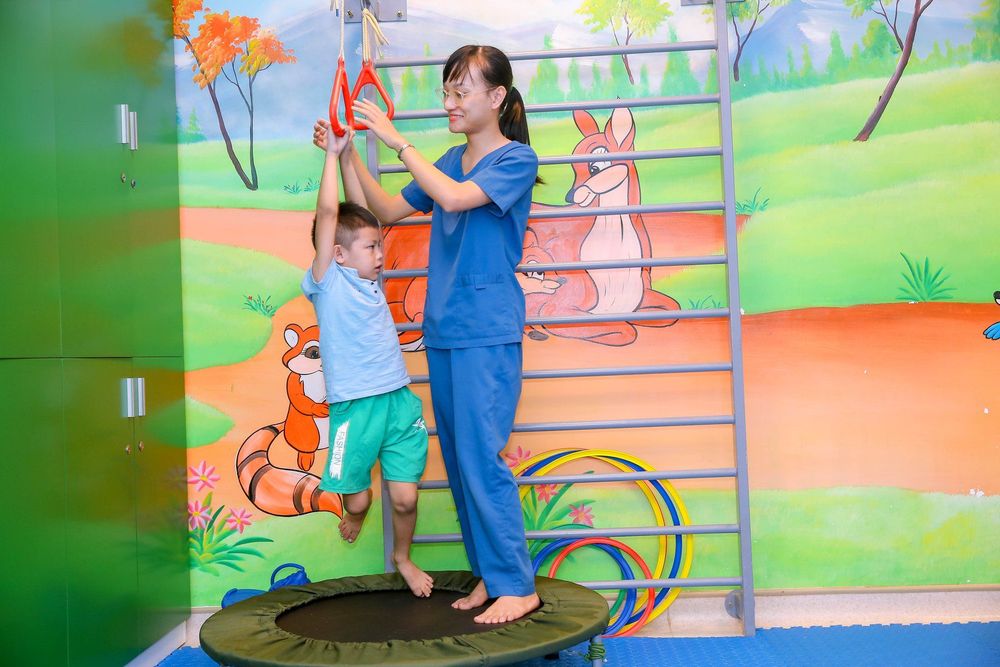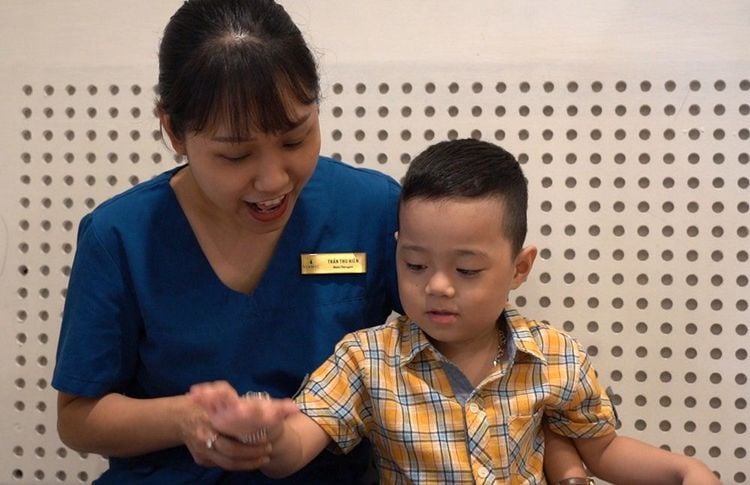This is an automatically translated article.
Autism spectrum disorders affect the way the brain works leading to a wide range of behavioral and social disabilities, from very mild to severe. Children with autism spectrum disorder have problems with communication and social interaction. Children also have repetitive behaviors, interests, and activities. About one-third of autism spectrum disorders in children cause intellectual disability.1. What is autism spectrum disorder in children?
Autism spectrum disorder (ASD) is a developmental disability that can cause significant social, communication, and behavioral challenges. On the surface, people with ASD look different from other healthy people, but people with ASD are different in communicating, interacting, behaving, and learning in different ways than most people around them. . The learning, thinking, and problem-solving abilities of people with ASD can range from genius to severe difficulty. Some people with ASD need a lot of help with daily living, and others may need less.Diagnosis of ASD now includes several conditions that were once separately diagnosed: Autism Disorder, Pervasive Developmental Disorder - Non-Specific (PDD-NOS), and Asperger's Syndrome. These conditions are now known as autism spectrum disorders.
Autism spectrum disorder (ASD) is a problem that affects a child's nervous system as well as growth and development. This disorder usually appears during the first 3 years of a child's life.
Some children with ASD seem to live in a world of their own. The child is disinterested in other children and lacks a sense of society. Children with ASD focus on following a certain routine, even if it's just normal behaviors. A child with this disorder also often has difficulty communicating with others. The child may not start talking as early as other children and may not want to make eye contact with others.

Rối loạn phổ tự kỷ (tên tiếng Anh là Autism spectrum disorder và viết tắt là ASD) là một khuyết tật phát triển có thể gây ra những thách thức đáng kể trong xã hội, giao tiếp và hành vi
2. Causes of autism spectrum disorder in children
Scientists do not yet know all the causes of ASD. However, a number of factors have been identified that may increase a child's risk of developing ASD. Besides, there can be many different factors that make a child more likely to have ASD, including environmental, biological, and genetic factors.Most scientists agree that genes are one of the risk factors that can make a person more likely to develop ASD.
Children with a sibling with ASD have a higher risk of developing ASD.
Much research has focused on genes that affect brain development and neurotransmitters (the way brain cells communicate), but experts think certain medical conditions may be linked to ASD . It is not yet clear how these conditions are directly related to ASD. People with certain genetic or chromosomal conditions, such as fragile X syndrome or tuberous sclerosis, phenylketonuria, fetal alcohol syndrome, Rett syndrome, Angelman syndrome, and syndrome Smith-Lemli-Opitz is more likely to predispose children to autism.
ASD can occur in all racial, ethnic and socioeconomic groups, but boys are 4 times more likely to have autism than girls. When taken during pregnancy, prescribed medications such as valproic acid and thalidomide are associated with a higher risk of ASD 15-16.
There is some evidence that the vulnerable period for the development of ASD occurs before, during, and shortly after birth. Children born to older parents have a higher risk of ASD.
Some parents worry that common vaccines given to young children, such as the measles-mumps-rubella (MMR) vaccine, might cause autism. Many large studies have not found any link between autism and these vaccines. According to the Institute of Medicine, the American Academy of Pediatrics and the Centers for Disease Control and Prevention (CDC), there is currently no evidence that vaccines cause autism.

Hiện nay chưa thể xác định được nguyên nhân dẫn đến ASD mà chỉ mới tìm ra các yếu tố nguy cơ có thể gây nên rối loạn phổ tự kỷ
3. Symptoms of autism spectrum disorder in children
Children with ASD often have problems with social, emotional, and communication skills. Children may repeat certain behaviors and may not want changes in daily activities. In addition, children with autism have different ways of learning, paying attention, or reacting to things. The signs of ASD begin in childhood and often last throughout a person's life.Children with ASD may have the following specific symptoms:
Do not point at objects to show interest (e.g. not at a passing plane) Do not look at objects when people other people point to objects have difficulty relating to others or are unconcerned about others Avoid making eye contact and prefer to be alone Difficulty understanding other people's feelings or talking about their own feelings No likes to be hugged or can only cuddle when he wants to. Child doesn't seem to know when people talk to them, but responds to other sounds Child may be interested in others, but doesn't know how to talk talk, play, or do something with them Repeat or imitate words or phrases that others say to your child, or repeat words or phrases in place of a normal response Has difficulty expressing a child's needs using words or emotional expressions Do not play "role-play" games Repetitive actions Difficulty adapting when a routine altered habits Have unusual reactions to many things smell, taste, see, feel, or sound Loss of skills the child used to have (for example, stops saying words he used to use)
4. Diagnosis and treatment of ASD in children

ASD đôi khi có thể được phát hiện khi trẻ 18 tháng tuổi trở xuống
ASD can sometimes be detected when a child is 18 months old or younger. By age 2, a diagnosis of ASD from an experienced professional can be considered very reliable. However, many children do not have a final diagnosis until they are older. Some people are not diagnosed until they are teenagers or adults. This delay means that children with ASD may not get the early help they need.
Early signs of ASD may include, but are not limited to:
Avoiding eye contact, Little concern for children or other caregivers Limited ability to express language (e.g. have fewer words than their peers or have difficulty using words to communicate) Discomfort from small changes in daily routine As children with ASD become adolescents and young adults, may have difficulty developing and maintaining friendships, communicating with peers and adults, or understanding behaviors that are expected at school or at work. In addition, these subjects also need regular health care because they may have other comorbidities such as attention deficit hyperactivity disorder, obsessive-compulsive disorder, anxiety or depression, or anxiety disorder. behavior.
Monitoring, screening, evaluating, and diagnosing a child with ASD as early as possible is critical to ensuring that children receive the services and supports they need to reach their full potential. There are several steps in this process.
4.2 Developmental Monitoring Track development by observing how your child develops and changes over time and whether your child is meeting typical developmental milestones for playing, learning, speaking, behaving and move or not. Parents, grandparents, child health workers and other caregivers may be involved in monitoring development. You can use a brief checklist of milestones to see how your child is developing. If you notice that your child is not meeting milestones, talk to your doctor or nurse about your concerns.
When you take your child for a check-up, the doctor or nurse will also monitor the child's development. The doctor or nurse may ask you questions about your child's development or will talk and play with your child to see if your child is growing and reaching milestones. A missed milestone could be a sign of something, so your doctor or another specialist will take a closer look using more thorough tests.
4.3 Developmental Screening Developmental screening helps to take a closer look at how your child is developing. Your child will receive a short test or you will complete a questionnaire about your child. The tools used for behavioral and developmental screening are child development questionnaires, which include language, movement, thoughts, behaviors, and emotions. Developmental screening can be done by a doctor or nurse, but can also be done by other professionals in a healthcare setting, community, or school.
Developmental screening is more common than developmental monitoring and is performed less frequently than developmental monitoring. Your child should be checked if you or your doctor notice any abnormalities. However, developmental screening is only one part of some health visits for children and for all children, even if the child does not have any abnormalities related to autism.
The American Academy of Pediatrics (AAP) recommends behavioral and developmental screening for all children during routine well-child visits for the following ages:
9 months 18 months 30 months In addition, AAP recommends that all children be specifically screened for ASD during doctor visits at:
18 months 24 months Additional screening may be needed if the child is at high risk for ASD (eg, the child have a sister, brother, or other family member with ASD) or sometimes engage in ASD-related behavior.
If your baby is at higher risk for developmental problems due to preterm birth, low birth weight, environmental risks such as lead exposure or other factors, your doctor may also discuss additional screening. fig. If a child has a long-standing health problem, he or she needs developmental monitoring and screening in all areas of development.

AAP khuyến cáo rằng, tất cả trẻ em nên được sàng lọc đặc biệt về ASD trong các cuộc thăm khám bác sĩ ở thời điểm 18 tháng và 24 tháng tuổi
The difference in how ASD affects each person is that people with ASD have unique strengths and challenges in social communication, behavior, and cognitive abilities. As a result, treatment plans are often multidisciplinary, may involve parent-mediated interventions and target the individual needs of the child.
Behavioral intervention strategies focus on developing social skills, especially when children will naturally acquire these skills and reduce restricted interests and repetitive behaviors repeat. For some children, occupational and speech therapy as well as social skills training and medication in older children may be helpful. The best treatment or intervention may vary depending on your age, health condition, problems, and individual differences.
Also remember that children with ASD can get sick or injured just like children without ASD. Regular physical and dental exams should be part of your child's treatment plan. Often, it is difficult to tell if a child's behavior is related to ASD or is caused by a separate health condition. For example, head-banging could be a symptom of ASD or it could be a sign that a child is having a headache or earache. In those cases, the child needs a comprehensive physical examination. Tracking developmental milestones doesn't just mean paying attention to the symptoms associated with ASD, but also your child's physical and mental health.

Hiện tại, không có phương pháp điều trị nào được chứng minh là có thể chữa khỏi ASD, nhưng một số biện pháp can thiệp có thể giảm thiểu các triệu chứng, cải thiện khả năng nhận thức của trẻ
Types of treatment can generally be divided into the following categories:
Behavioral and Communication approaches Dietary approaches Medicine Complementary and alternative medicine Children between 6 months and 3 years of age are very common Having respiratory problems, respiratory infections, skin diseases and gastrointestinal infections... Parents need to pay special attention to caring for and providing adequate nutrition for children. . The pediatric department at Vinmec International General Hospital is the address for receiving and examining diseases that infants and young children are susceptible to: viral fever, bacterial fever, otitis media, pneumonia in children. With a system of facilities, modern medical equipment, sterile space, minimizing the impact as well as the risk of disease spread, Vinmec will bring satisfaction to customers. and is highly appreciated by industry experts with:
Gathering a team of leading pediatricians: Including leading experts with high professional qualifications (professors, associate professors, doctors, Master's degree), experienced, worked at major hospitals such as Bach Mai, 108.. The doctors are all well-trained, professional, conscientious, knowledgeable about young psychology. In addition to domestic pediatric specialists, the Department of Pediatrics also has the participation of foreign experts (Japan, Singapore, Australia, USA) who are always pioneers in applying the latest and most effective treatment regimens. . Comprehensive services: In the field of Pediatrics, Vinmec provides a series of continuous medical examination and treatment services from Newborn to Pediatric and Vaccine,... according to international standards to help parents take care of their baby's health from birth to childhood. Advanced techniques: Vinmec has successfully deployed many specialized techniques to make the treatment of difficult diseases in pediatrics more effective: neurosurgery - skull, stem cell transplant blood in cancer treatment. Professional care: In addition to understanding children's psychology, Vinmec also pays special attention to the children's play space, helping them to play comfortably and get used to the hospital's environment, cooperate in treatment, improve the efficiency of medical treatment.
Please dial HOTLINE for more information or register for an appointment HERE. Download MyVinmec app to make appointments faster and to manage your bookings easily.
Reference source: babycenter.comSEE MORE
Stem cell therapy in autism treatment Protein coding genome sequencing detects genetic changes in children with autism in Vietnam Autism spectrum disorder is What, causes and treatment













